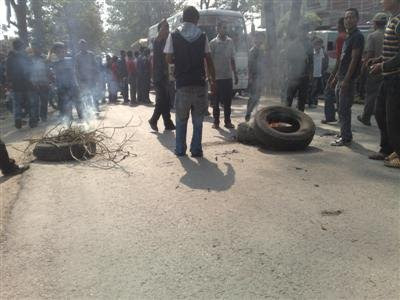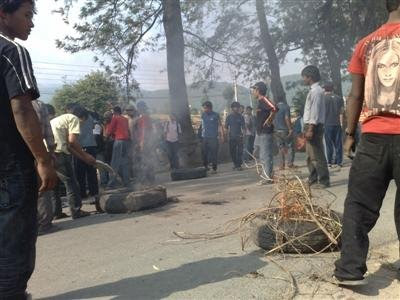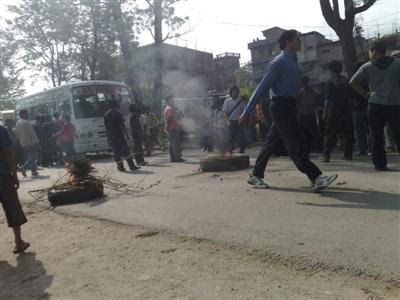Meandering of river: There are more than six thousands of rivers in Nepal. This picture is of Rapti river in Chitwan National Park. No need to explain further for this scene.
Saturday, January 5, 2013
Roaming in Nepal
Meandering of river: There are more than six thousands of rivers in Nepal. This picture is of Rapti river in Chitwan National Park. No need to explain further for this scene.
Thursday, March 10, 2011
Building Kathmandu

Posted by
Saggyani
at
5:53 AM
0
comments
Labels:
Kathmandu,
Nature,
Nepal
![]()
Thursday, October 28, 2010
A visit to Sri Lanka
A month ago, I was visiting Sri Lanka for a office work. I like the place due to its greenery and a system developed for basic things like drinking water, education and health. I had an impression that the country must be in a painful condition due to thirty years of war but I didn't feel that after my visit. I got a feeling that if it would not have faced the war, it would have really become a 'pearl' of Asia a long back. Here are some pictures taken during my visit.
Posted by
Saggyani
at
2:32 AM
0
comments
Labels:
Nature,
Sri Lanka
![]()
Friday, May 21, 2010
Wild berry from Nepal
This wild berry's picture is from Kavre, Nepal. I don't know the scientific name of it but in Nepali it is called 'bhui yaiselu' meaning 'ground berry'. Some people also called it 'a berry of snake' but it is edible and some people even compare it with strawberry. If we look carefully, the seeds and wart in the fleshy fruit resembles to strawberry but smaller in size compare to strawberry. It is also round in shape where as strawberry is oval in shape. If you know the exact name and scientific name of it, share with me.
Posted by
Saggyani
at
10:52 AM
0
comments
Labels:
Ground berry,
Nature,
Nepal
![]()
Wednesday, May 5, 2010
Godawari: Botanical garden Nepal
Posted by
Saggyani
at
6:24 AM
0
comments
Labels:
Botanical garden,
Nature,
Nepal
![]()
Monday, May 3, 2010
Flowing water: peace of mind
Sunday, May 2, 2010
Some flowers from Godawari
Tuesday, March 2, 2010
Traditional wooden pots from Nepal
Posted by
Saggyani
at
9:35 AM
0
comments
Labels:
culture,
Nature,
Nepal
![]()
Hail stones hits Kathmandu
While scientists are fightings with 'global warming', almost at the end of winter season, Kathmandu is hit by large amount of hail stones. It was windy night and all of a sudden, I hear 'pop' sounds above my roof. I came out of my room and saw white balls hitting hard to roof, ground and my flower pots. Oh! in a very short period of time, the amount of hail stone was so high that I have not seen before. It covered the streets, ground and everything within five minutes time. Enjoy the pictures of the same event occured just yesterday.
Posted by
Saggyani
at
9:23 AM
0
comments
Labels:
Environment,
Nature,
Nepal
![]()
A visit to Manakamana Temple
Few weeks back, I visited Manakamana temple. The devi is belived to fulfill the will of everyone. I don't know whether everyones will is fulfilled but I enjoyed the natural beauty on the way to temple and scenes from the cable car. Hope you will also enjoy the trip with these few pictures.
Posted by
Saggyani
at
9:16 AM
0
comments
Labels:
Environment,
Nature,
Nepal
![]()
Sunday, November 1, 2009
Yellow insect turn black
Earlier I had a post on social insects. I was not sure whether they are ants or spiders. When I checked the site of the picture again, I was surprised to see those insects again but with different colour. They have turned black. How could be? I looked closely. I found that they have developed wings and long antenna. Because of the wings they looked black. Though they have wings now, they have not flied yet. I will keep my eyes on what change they will have next.

Posted by
Saggyani
at
8:03 AM
0
comments
Labels:
Environment,
Nature,
Nepal
![]()
Thursday, October 29, 2009
Be social like these insects
Posted by
Saggyani
at
11:02 AM
0
comments
Labels:
Environment,
Nature,
Nepal
![]()
Thursday, August 27, 2009
Bamboo as home utensils
The text in Nepali (below the picture) says that: The picture is from Sankhuwasawa Sisukhola-2 where Gorimaya Rai is filling bamboo pot with drinking water. They do not have bucket or water pot to collect water. Other people in the village also use bamboo as spoon, cooking utensils and others. As cooking utensils, they put rice and water in bamboo pot and put near fire to cook. Click the picture for larger form.
Posted by
Saggyani
at
10:49 AM
0
comments
Labels:
culture,
Nature,
Nepal,
Technology
![]()
Monday, June 15, 2009
Tuborg house
Posted by
Saggyani
at
11:14 PM
0
comments
Labels:
agriculture,
Environment,
House,
Nature,
Nepal,
Tuborg
![]()
Natural bugs
Posted by
Saggyani
at
11:09 PM
0
comments
Labels:
Bugs,
Nature,
Nepal
![]()
Wednesday, May 6, 2009
Open tires burning, environmental pollution and health impact
Open tire fire emissions include carbon monoxide (CO), sulfur oxides (SO2), oxides of nitrogen (NOx), and volatile organic compounds (VOCs). It also includes hazardous air pollutants such as polynuclear aromatic hydrocarbons (PAHs), dioxins, furans, hydrogen chloride, benzene, polychlorinated biphenyls (PCBs). The tire burning emission also releases heavy metals like arsenic, cadmium, nickel, zinc, mercury, chromium, and vanadium. People exposed to such emissions show symptoms of skin, eyes, and mucous membranes irritation, lungs and respiratory problems, central nervous system depression, and cancer. In a long run people may start showing mutagenic effects and higher number of cancer cases. In terms of mutagenic effects, open tire fires emissions are 16 times more dangerous than residential wood burning and 13,000 times than coal-fired emissions.
May be we will start stopping lighting the tires only we experience such effects ourselves but that will be too late to act on. (Information source: http://www.elaw.org/node/2764; Pictures by blogger)
Posted by
Saggyani
at
9:50 AM
0
comments
Labels:
culture,
Environment,
Kathmandu,
Nature,
Nepal,
Pollution,
Traffic
![]()









.jpg)
.jpg)
.jpg)




